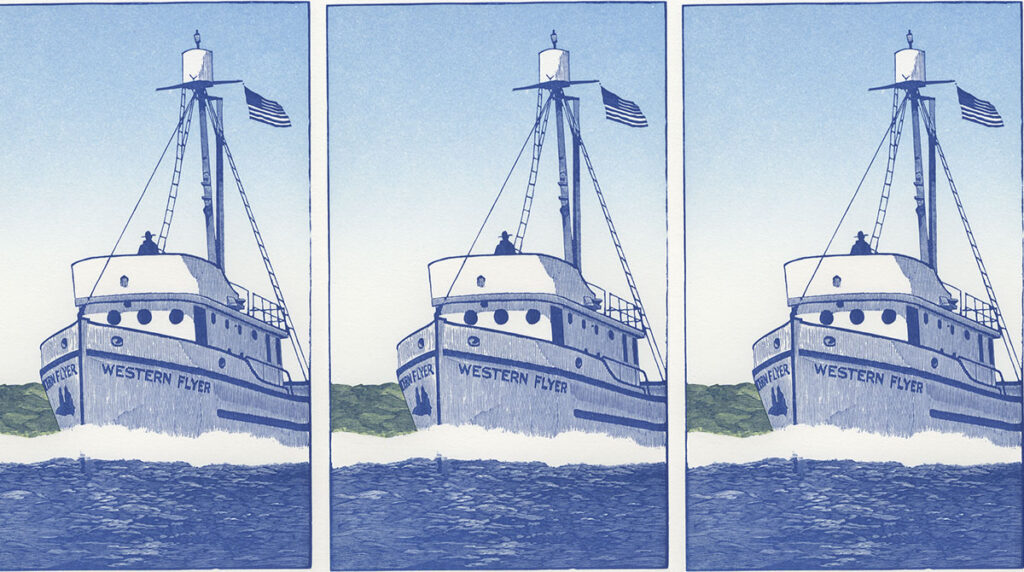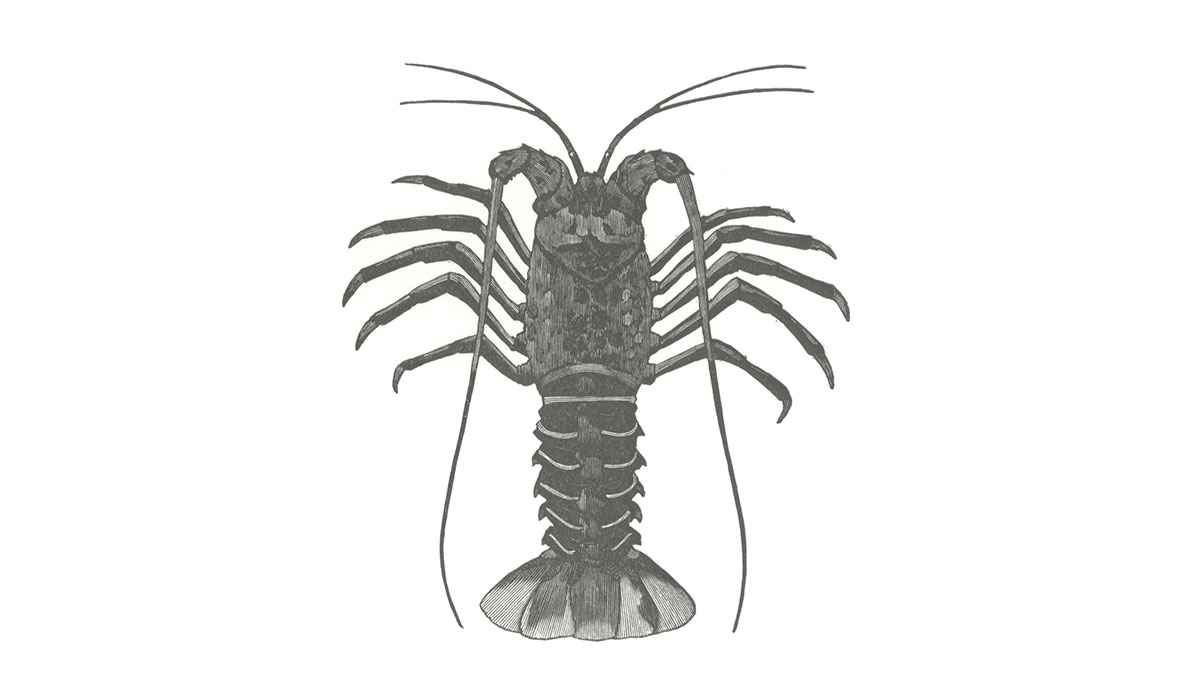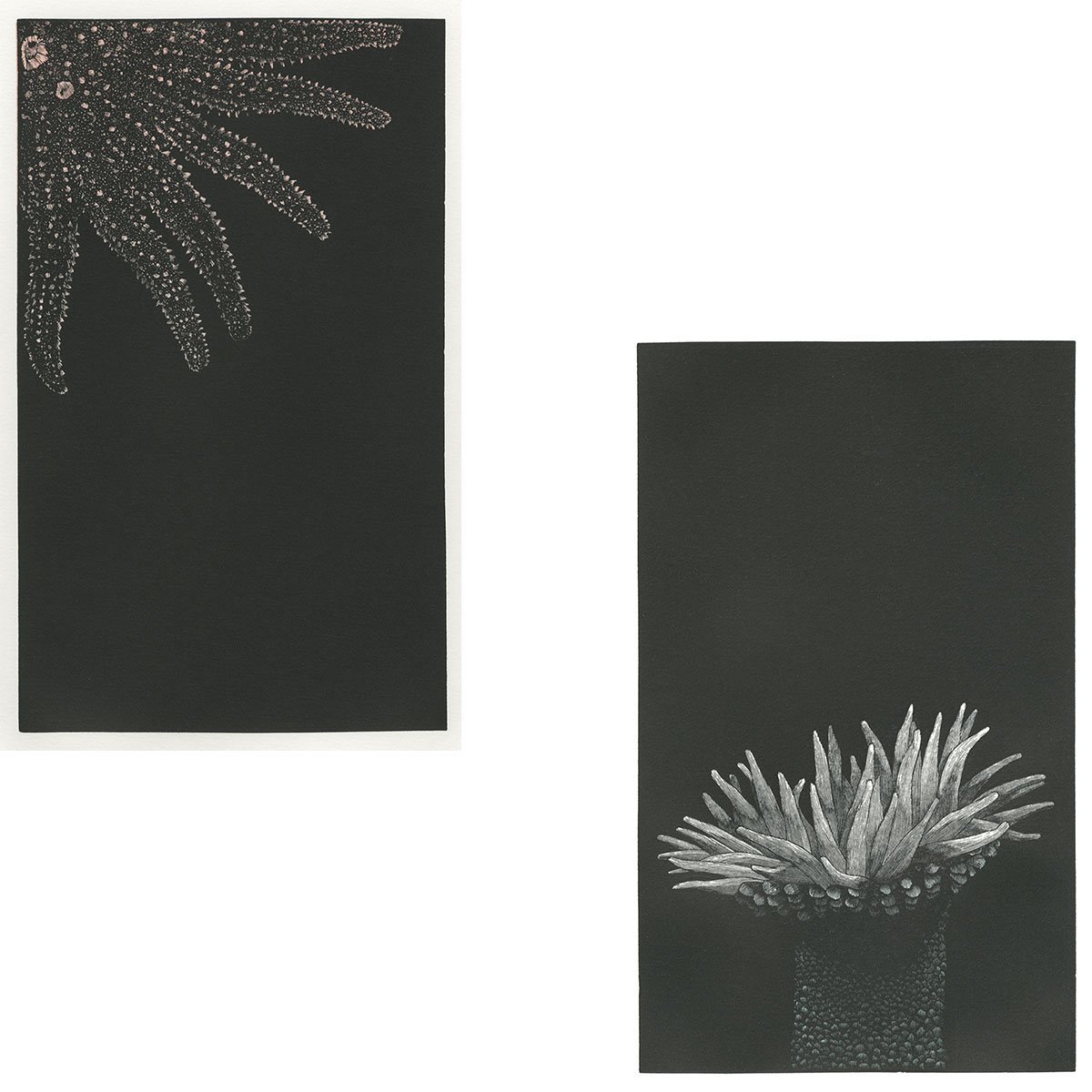Mavericks at Sea
Eighty years on, Steinbeck and Rickett’s holistic view of the oceans feels more urgent than ever

In March 1940, the sardine boat Western Flyer headed south from Monterey for a bioblitz of marine life along the Baja California peninsula. Aboard the charter were 38-year-old John Steinbeck and his best friend, biologist Ed Ricketts. Both men were on the run that spring: the novelist unnerved by global fame after The Grapes of Wrath, the self-taught scientist nearly broke. Fire had destroyed Ricketts’s lab, and he needed new specimens, fast, for study and for sale.
Steinbeck underwrote both rebuilding and expedition. His affection for ocean research and seafaring already bordered on the mystical, and the more time he spent with Ricketts the more he brooded on the strangeness of connection, natural and personal. “How deep this thing must be, the giver and the receiver again,” he wrote of their Pacific journey. “Man receiving back from Boat a warping of his psyche so that the sight of a boat riding in the water clenches a fist of emotion in his chest.”
The Western Flyer was not easy to love. Formaldehyde jars of ribbon worms, sun stars, and sea-hares soon jammed every cabin. The skiff’s outboard motor was all diva (fond of “trailing its propeller daintily in the water while we rowed … and when attacked with a screwdriver fell apart in simulated death”). The Carta Blanca beer kept running out. The ship’s radio broadcast the Nazi invasion of Norway.
Yet on their six-week, 4,000-mile trip, Ricketts and Steinbeck, working flat out, produced exemplary science, describing and preserving more than 500 specimens of Gulf of California fauna—what Ricketts called the “good, kind, sane little animals” of the intertidal zone. Their survey also revealed dozens of new species, like the sea anemones that now bear their names: Palythoa rickettsii, Philoba steinbeck.

Back ashore, dreaming of royalties, they assembled an expedition account that combined Ricketts’s catalogue and daily notes, polished and revised by Steinbeck in a narrative voice no longer “I” but “we.” Both men thrilled to the old evocative name for the Gulf, and so chose as their book title Sea of Cortez: A Leisurely Journal of Travel and Research. Steinbeck half-hoped for critical outrage—he loathed being pigeonholed—but reviews were respectful, if baffled. And largely unread: most ran the week of December 7, 1941.
Sea of Cortez is intensely modern, a wayward collage of taxonomy, travelogue, and philosophy that anticipates the New Journalism. Steinbeck needed a change after completing his great labor trilogy: In Dubious Battle (1936), Of Mice and Men (1937), and The Grapes of Wrath (1939). The book burnings that greeted the latter shook him badly. Running away to sea freed him in every way, not least to blur the line between fiction and reporting. Kernels of fact became imagined scenes, amplified dialogues, freeform meditations on meaning. (What he elides or leaves out can be nearly as interesting, notably the presence on board throughout of the first Mrs. Steinbeck.)
Cortez blows up that deep literary taboo, the open acknowledgment of collaboration. Music and dance can have duets, architects (and scientists) work in teams; literature craves the heroic solo. Ricketts’s death was widely mourned—his circle included Henry Miller, Lincoln Steffens, Joseph Campbell and John Cage—but a second, silent casualty was almost certainly Steinbeck the top-notch science writer. After Ricketts, that door stays closed, and locked.
The coauthors never made a dime on Cortez. Ricketts spent the war in an Army lab, Steinbeck as an overseas correspondent for the New York Herald Tribune. But Ricketts’s plea for marine conservation eventually confirmed him as a philosopher-prophet of ecology, the gentle bohemian who loved natural context and understood that disturbance was fatal, to spiny lobsters, to hermit crabs, to us. Sea of Cortez now stands with Marjory Stoneman Douglas’s River of Grass (1947), Aldo Leopold’s A Sand County Almanac (1949), and Rachel Carson’s Silent Spring (1962) as a landmark of American environmental literature.
In 1951, their book was reissued by Viking as The Log from the Sea of Cortez, catalogue excised, eulogy added. But the stately second version pales beside the wind and brine of the original, written by friends feeling their way toward a maverick, holistic vision of the oceans—and the cosmos. Steinbeck, especially, read physicists Einstein and Bohr with fascination, hoping he and Ricketts might also craft some unifying theory to sweep literature and the life sciences toward stranger latitudes. As their Easter Sunday chapter notes, “one thing is all things—plankton, a shimmering phosphorescence on the sea and the spinning planets and an expanding universe, all bound together by the elastic string of time. It is advisable to look from the tide pool to the stars and then back to the tide pool again.”
To commemorate the 80th anniversary of the Ricketts-Steinbeck voyage, San Francisco’s Arion Press will be issuing this fall a limited edition of the original Sea of Cortez. The firm is celebrated for its superb artist’s books, printed by letterpress, bound by hand; Arion’s 115-item backlist pairs Moby-Dick with wood engravings by Barry Moser, the Porgy and Bess libretto and Kara Walker lithographs, and a Seamus Heaney sequence and Sol Lewitt drawings.
For Cortez, Arion commissioned Richard Wagener to produce exquisite, somber boxwood engravings of sea-life, and 250 quarto copies were printed from metal types cast expressly for the project. (To watch the printing of the tint plates, click here.) A portion of the edition, Arion notes, is bound in quarter leather and presented in a deluxe housing crafted from the old-growth fir planks of the Western Flyer itself. The vessel, recently salvaged, is being restored by a foundation for use in education and basic research, with a silent hybrid-electric engine, high-tech classrooms below decks, and a remotely operated submersible able to explore more than two miles down.

Ricketts died in a car-train crash in 1948. He and Steinbeck had been planning another survey voyage, this time along the British Columbia coast. Steinbeck never got over the loss; Ricketts was, he once said, “the other half of my brain.”
Devotees from around the world still visit the site of Ricketts’s bio lab and raise a beer to the man who upended marine biology. Even when Steinbeck used him as the model for Cannery Row’s drunken mystic Doc, “half Christ and half satyr,” Ricketts forgave, as Steinbeck knew he would. Their relationship, he said later, was “closer than most friends and closer than most husbands and wives.”
Steinbeck won the Nobel Prize in 1962 and died of heart disease in 1968, a specimen out of deep time, stranded above the high-tide line. His penultimate book, Travels with Charley, punctuates Cortez, not happily; old man and old dog in a camper-bus tour of a shiny, shallow, race-torn, postnuclear America, yearning for connection.
But the loneliness of the empty shotgun seat marks every mile, unlike those long-ago mornings on the eel-grass flats when John Steinbeck and Ed Ricketts felt suddenly dissolved into “barnacle and rock, rock and earth, earth and tree, tree and rain and air. And the units nestle into the whole and are inseparable from it.”

